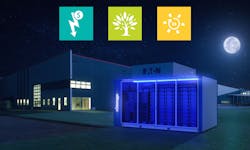Energy storage systems provide essential functionality for electrical infrastructure. With massive projected increases in renewable energy generation and transportation electrification on the horizon, electrical professionals must be able to safely and economically manage energy storage systems.
When battery storage is combined with renewables, homes, businesses, and communities can address the intermittency challenges and manage electric vehicle (EV) charging ― while also reducing energy costs, earning revenue through energy market participation, and contributing to the stability of the larger electrical grid.
The installed base of energy storage is expected to increase 13 times by 2030, according to Bloomberg New Energy Finance. Lithium-ion (Li-ion) batteries, whether used for emergency power or to complement distributed energy resources or inside of vehicles, have a critical role in this growth. Bloomberg reports the cost of these batteries has fallen nearly 90% over the last decade. As a result, the technology is increasingly found in uninterruptible power supply systems (UPSs), emergency power systems, and distributed energy installations around the world.
While battery technology continues to evolve, codes and standards for safe application are also changing, and new guidelines for testing are being introduced. Staying informed on new standards and testing guidelines is critical. It is also essential to recognize that the safety of energy storage doesn’t start and end at the battery.
Safety codes
Several electrical industry organizations currently offer guidelines and best practices for the installation and testing of battery energy storage technology. The two most recent code developments for energy storage systems include:
- NFPA 855: Standard for the Installation of Stationary Energy Storage Systems, and
- UL 9540A Test Method: A test method for fire safety hazards associated with propagating thermal runaway within battery systems.
There is an entire ecosystem of working components that are part of energy storage systems, and each one has a role to play in enhancing the safety of the overall system. These components have long been required by NFPA codes and include unique certification criteria for circuit protection devices, inverters, battery management systems, and more. Testing methodologies outlined by UL 9540A should be considered in line with the NFPA 855 guidelines to ensure the long-term safety of battery energy storage systems.
Testing guidelines
A thorough understanding of the testing process UL recommends for safe energy storage installation and operation will help you provide your local authorities, insurance providers, and fire mitigation professionals with the information they need to quickly assess the safety of your installed battery energy storage system (BESS).
The UL 9540A test method was developed to evaluate the potential for thermal runaway fire propagation, should it occur during the life of the system. It addresses key issues identified by building codes and the fire service, including:
- Proper BESS installation
- Compliance with installation ventilation requirements
- Effectiveness of fire protection (integral or external)
- Applied fire service strategy and tactics
Here’s a high-level look into how the testing process works:
- Cell level test: Whether the battery cell itself can exhibit thermal runaway and if the connected battery management system (BMS) can take appropriate action to mitigate the problem.
- Module level test: Determining the propensity for propagation of thermal runaway and effectiveness of BMS control systems.
- Unit level test: Evaluation of fire spread should a thermal event occur.
- Installation level test: Effectiveness of physical fire protection systems.
Layers of protection
Batteries are one part of energy storage systems. A number of other codes and standards apply to the other components in the system. They include:
- UL 489 circuit breakers provide overload (thermal) and short-circuit (magnetic) protection to a circuit and its downstream components like batteries.
- UL 489B molded-case circuit breakers, molded-case switches, and circuit breaker enclosures are certified for use with photovoltaic (PV) systems and DC applications.
- UL 1741 storage inverters are certified to remain online and automatically adapt power output in real-time to stabilize the electric grid during periods of abnormal operation, such as heat waves or brownouts.
- UL 1998- and UL 1973-certified battery management systems provide confidence that the battery and related management systems support safety functions in the case of a failure.
Advancing safety
Energy storage is growing and has vast potential to transform how we produce and consume electrical energy. To support the growth of this transformative technology, it is essential that proper precautions be put into place to advance safety.
Understanding the codes and standards related to energy storage is a start, but many requirements vary by region. Use the latest NFPA guidelines as a baseline when designing and installing a BESS, and find confidence in the thorough testing and reporting processes outlined by UL 9540A. Most importantly, consult early and directly with local AHJs during the conceptual or design stage of the project. If waivers or exceptions to the codes are applicable, the AHJ may have the final say. Direct consultation will provide the confidence that the planned installation will be accepted and approved.
Battery safety is a critical factor to the technology’s widespread adoption in the energy marketplace. A commitment to safety when it comes to the installation and operation of these systems will enable the energy transition with a more dynamic ecosystem capable of providing much more sustainable electricity than ever before.
Ed Spears leverages nearly 40 years of power systems experience to support customers’ energy resiliency needs. He works for Eaton’s Critical Power Solutions Division in Raleigh, N.C. He can be reached at [email protected]
About the Author



